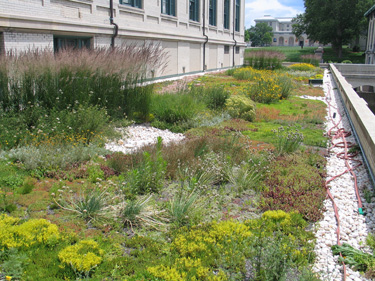Gardens in the sky
Green roofs provide a host of advantages for city living
Green (or Living) roofs have been mentioned before in this column (Weekend Gardener issue 383) and are becoming increasingly popular across the world, particularly in Northern Hemisphere cities. This is because of the incredible number of benefits which plants on a roof can lend to the occupants of the building and to the wider community and the environment.
- Storm water management - impermeable roofs collect rainwater and direct it into the drainage system which, in heavy rain events, can lead to flooding and pollution of rivers, lakes and the sea. A green roof acts like a sponge, capturing the water for the plants before slowly releasing it – much the same way a forest does. This reduces the total output of storm water as well as the rate at which it flows into drains.
This ability to improve storm water flows is a major appeal to urban planners in cities that are frequently inundated by heavy rainfall. - Air & water quality clean up – pollution and greenhouse gases are a major concern. Plants remove atmospheric carbon dioxide and release oxygen. In addition the substrate and vegetation of a green roof can absorb a range of pollutants including nitrogen, phosphorus and heavy metals.
- Energy efficiency – green roofs offer insulation, keeping the heat inside in winter and the cool air inside in summer. In addition a green roof will reduce the air temperature by some 10 degrees C, compared to a traditional roof, thereby alleviating the “urban heat island effect”.
- Increased bio-diversity – green spaces in urban environments increase habitats for birds, insects and other small animals. With some species this may be a disadvantage; however it has been found that in large cities green roofs provide a predator-free stepping stone for migratory birds. A green roof can also be designed specifically to colonise some species such as bees and skinks.
- Aesthetic enhancement – all gardens and green spaces are easy on the eye and a green roof is just the same, even if it can only be enjoyed by the building occupants or seen from a higher building or the air.
- Community amenity – many inner city buildings are apartments that have little or no room for greenery. A green roof provides a community space for residents with amenities that encourage social gatherings such as a community vegetable garden, lounges and barbeques.
- Extended roof life – a green roof will protect the roof membrane from light and weather which in turn can extend the life of the roof by two or three times.
- Increased property values – a green roof can increase the value of a property by as much as 9%.
Despite the proven benefits of green roofs, there is a perception that they are too hard to implement. Concerns include high installation costs, the weight, maintenance and doubt over their effectiveness. In New Zealand a small number of inner city green roofs have been installed, examples being Pipitea Plaza Wellington, NZI building Auckland, Waitakere Civic Centre Auckland and both the Auckland and Otago Universities. Christchurch City Council has included green roofs in their Draft Christchurch Central City Plan, and it is proposed to encourage living roofs and walls in the Central City.
There is no direct legal requirement to provide a green roof in New Zealand, but anywhere a new building is planned, and Christchurch has the greatest opportunity, we should advocate with town planners and building architects to include green roofs so our cities can reap the benefits.
Watch the “Living Roofs” video on the Greenlife Matters links page www.gogardening.co.nz/in-the-garden/2-0-1296/greenlife-matters-videos-and-links

15-Apr-2016


